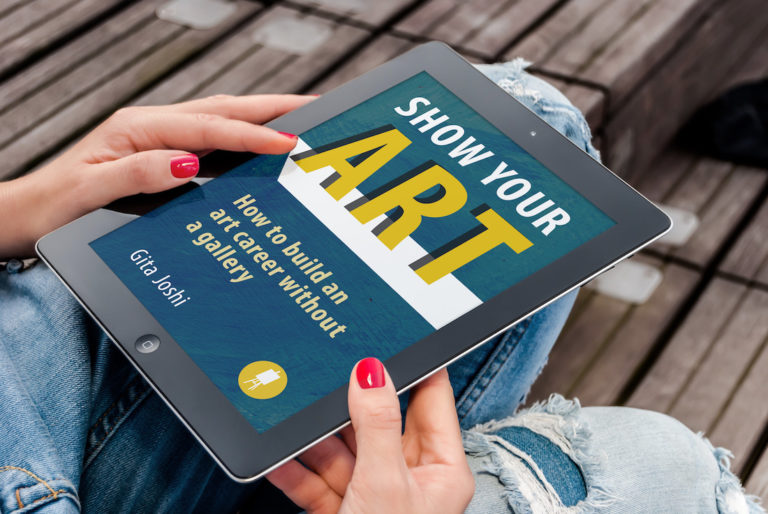Being represented by a gallery remains a career aspiration for many artists. Yet a new book titled Show Your Art: How to Build an Art Career Without a Gallery advises that even established artists with regular gallery shows should no longer rely purely on galleries for sales, and outlines the steps that artists should take to find an audience, establish their reputation, and sell their work.
ArtWeb spoke to its author, curator and artist coach Gita Joshi, to learn more.

If artists can sell without galleries, do they still need gallery representation?
The book draws on Joshi’s own experience as a gallerist (she opened and ran Orso Major, an award-winning gallery in Waterloo, London, from 2013 to 2016). It also aims to serve as a resource answering the questions she has received from many of the artists whom she mentors.
Despite its subtitle, Joshi argues that galleries still have a role to play in an artist’s career. She sees galleries as a useful tool in an artist’s armoury: ‘a successful artist’s business is not reliant on galleries, but is a blend of selling directly to their own audience, and working with galleries alongside this,’ Joshi advises. ‘Artists can be — and have to become — the best advocates of their work.’ They should see galleries as just one income stream in a diversified and resilient business model, not a single path to success. Moreover, artists who successfully build their own following and become adept at marketing their work are more likely to attract the interest of galleries, and should recognise their audience as an asset.
The foundations for success in an art career
The book highlights the fact that it has never been easier for artists to connect with others, share their work, and build relationships with clients. In order to do so, Joshi identifies four key building blocks that artists must develop:
1. An artist statement that clearly communicates the ideas behind artists’ work, without jargon. Originally released as an ebook, Show Your Art is now available in a print format that includes exercises and worksheets to help artists develop their strength as a storyteller, and which can be used as the basis for an artist statement.
2. A website that acts as a comprehensive source of information about the artist and their work. The book includes practical tips for creating a website, including the key facts that should be included in an artist’s biography, and even the size of images that should be uploaded to it.
3. A strong and carefully curated presence on social media. Joshi acknowledges that it can take time to develop this, but states that ‘if you have faith and belief in yourself, and put in the time consistently, you will find your people.’
4. A mailing list of contacts. Joshi recommends keeping contacts regularly updated on your work, rather than only sending out an email every time you have a new painting for sale. Instead, artists should send contacts updates about their work and life at least once a month. This chapter of the book suggests software that will help artists do this, along with ideas for subjects to include in newsletters.

How else can artists sell their work?
Having put the time into crafting an artist statement, building a website, developing their presence on social media and regularly sending e-newsletters, the next steps that the book recommends include:
– Taking part in open studios.
– Applying for open calls and juried exhibitions. These are also often attended by journalists, curators, and gallerists on the lookout for new talent.
– Attending artist fairs. Joshi shares some key advice on how to survive your first art fair (including avoiding the opening night’s champagne), and how to engage with visitors to your booth.
– Hiring a space to hold your own exhibition, with suggestions on how to choose a location, and companies that list spaces for hire.
Any other tips?
Finally, Joshi also shares her advice on marketing events (including a timeline of how far in advance you should send out invitations), and attracting media coverage of them and your work. Just like building a presence on social media, gaining press coverage can take time; she recommends getting to know publications and the journalists that write for them before approaching them about your work, and doing so in good time before a show.
Why read the book?
When it was published in April, Show Your Art swiftly became a bestseller in Amazon’s Art Business charts, and it is easy to see why. Although written with visual artists in mind, it contains advice that any form of creative, from writers and musicians to graphic designers and actors, will find helpful. At a time of great uncertainty in the art world, the foundations that Gita Joshi encourages artists to develop — a strong online presence, confidence in discussing and sharing their work, and an engaged audience — seem more vital than ever.

Where to buy the book
Putting her own advice into practise, Joshi chose to launch Show Your Art on Amazon Kindle, rather than working with a traditional publisher. It can be purchased as an ebook or in a printed format here.





